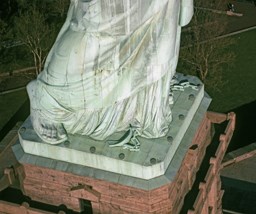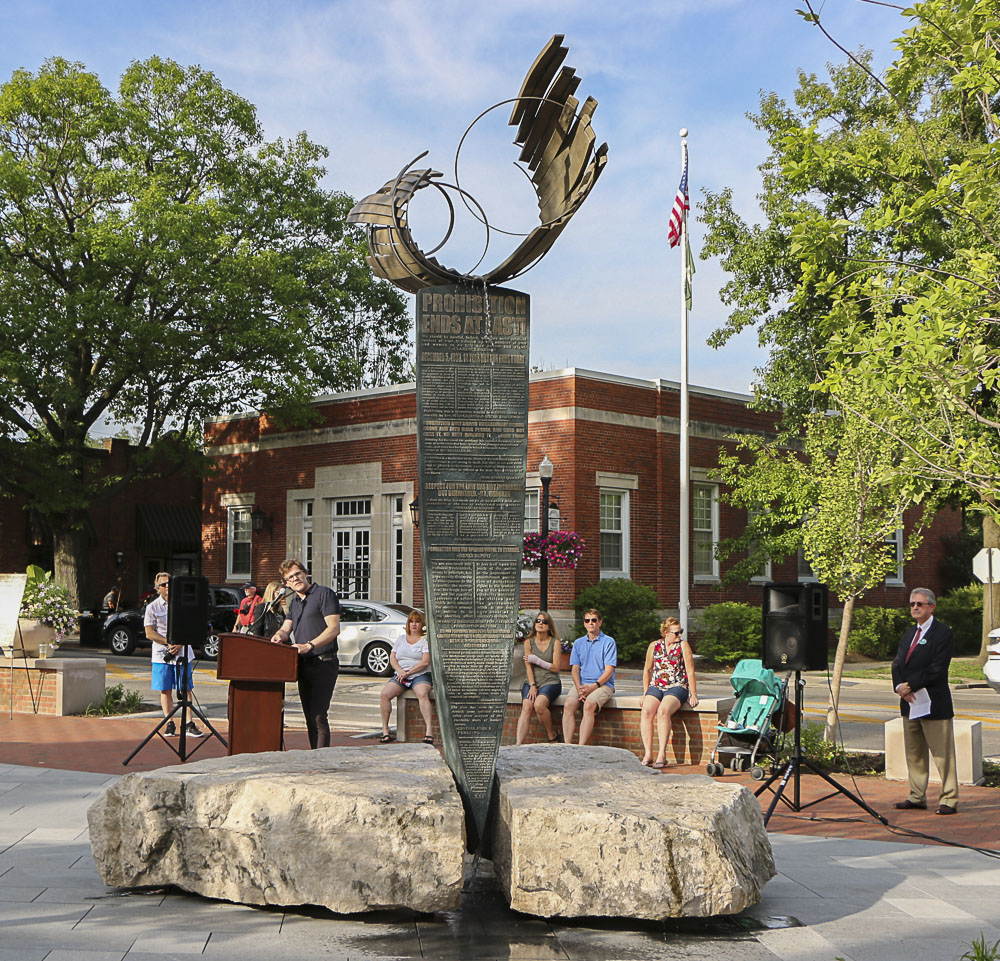![By SethAllen623 [CC BY-SA 3.0 (https://creativecommons.org/licenses/by-sa/3.0) or Public domain], from Wikimedia Commons](https://www.motleymoose.com/wp-content/uploads/2018/08/Jeopardy_game_board.png)
What is what I didn’t know about the Statue of Liberty, and why is that?
Statue of Liberty Wears Chains and Shackles Honoring Freed Slaves https://t.co/AYdPi9uFzu pic.twitter.com/Pn9YR58KWm
— Sharon Kyle (@SharonKyle00) March 12, 2017
When Laboulaye’s Statue of “Liberty Enlightening the World” was completed, it not only represented democracy but also symbolized American independence and the end of all types of servitude and oppression. A broken shackle and chain lie at the Statue’s right foot. The chain disappears beneath the draperies, only to reappear in front of her left foot, its end link broken. However, although the broken shackle is a powerful image, the meaning behind it was not yet a reality for African Americans in 1886.
After the Statue’s dedication in 1886, the Black Press began to debunk romantic notions of the Statue of Liberty and American History. Racism and discrimination towards African Americans did not end after the Civil War or with the dedication of the Statue – it continued on for more than a century. As a result, the Statue was not a symbol of democratic government or Enlightenment ideals for African Americans but rather a source of pain. Instead of representing freedom and justice for all, the Statue emphasized the bitter ironies of America’s professed identity as a just and free society for all people regardless of race. From the time of the Statue’s dedication, attitudes towards the Statue in the African American community were ambivalent and uncertain. Abolition

The Bellamy Salute. [In the form of a question, please.] Oops…what is the Bellamy Salute?
The origins of the pledge trace to the late 19th century, the product of an expansionist American project. In 1891, the family magazine Youth’s Companion asked 35-year-old Francis Bellamy, a former pastor of Boston’s Bethany Baptist Church, to fashion a patriotic program for schools around the country to commemorate the 400th anniversary of Christopher Columbus’s “arrival in America” by “raising the U.S. Flag over every public school from the Atlantic to the Pacific.”
In just 23 lean words, Bellamy attempted to capture the “underlying spirit” of the American Republic. In so doing he wrote his way into the history books: “I pledge allegiance to my Flag and to the Republic for which it stands — one Nation indivisible — with liberty and justice for all.” The ugly history of the Pledge of Allegiance — and why it matters
A few details not mentioned above in those sanitized paragraphs:
Was that before or after they fixed that awkward Bellamy salute?#Murica #MAGA#MAGAFA ???????????????????????? pic.twitter.com/UAxzaVYUbQ
— Atheistic One (@atheistic_1) May 24, 2018
It didn’t take long for the Pledge to become wildly popular, even omnipresent. At schools, at campgrounds, at public gatherings, in Congress, people routinely faced the flag and pledged their allegiance to it.
Because, inherently, there is something physically awkward about people simply standing in place, their arms hanging limply by their sides, staring at a flag and reciting a pledge, it was decided that devising a salute would be appropriate.
Instructions for carrying out the salute were printed in the pages of Youth’s Companion. The gesture came to be called the Bellamy Salute, in honor of the Pledge’s author.
The Bellamy Salute consisted of each person — man, woman or child — extending his or her right arm straight forward, angling slightly upward, fingers pointing directly ahead. The peculiar history of the Pledge of Allegiance
The answer is The American Issue. The question is, “What is the newest public statue in Westerville, OH?”

Named The American Issue, the sculpture tells the story of Westerville’s role 100 years ago as the intellectual and logistical center for the passage of the 18th Amendment. The constitutional change prohibited the manufacture, sale or transportation of “intoxicating liquors” in the United States. The sculpture was privately funded and donated to the City in spring 2018.
Learn from the artist himself the significance of the elements:
The limestone boulder represents the people of the United States, the bedrock of the Nation. The stone is split and divided by a large wedge with quotes printed on opposite sides.
The design of the quotes on the wedge evokes the news journals of the day and the use of raised lettering is symbolic of the printing presses used to print The American Issue, the official journal of the Anti-Saloon League.
Balanced atop the wedge is a barrel used to distribute alcohol. The barrel is unraveling, symbolizing the barrel’s inability to “contain” the prohibition conflict even after the passage of the 18th Amendment. The unfurling of the barrel has a slightly helical shape referring to a strand of DNA and the influence of heredity in the disease of alcoholism.
Water, representing alcohol, perpetually flows from the barrel down both sides of the wedge, over both sides of the issue, symbolizing the complex nature of this social issue.“The sculpture represents the dualism within each of us as we choose the paths of meaning in our lives, to live fully and freely, with a moral code that minimizes suffering and provides the basis for the betterment of ourselves and our society,” Palmer said in an artist’s statement. The American Issue Sculpture
What is just another example of white appropriation and erasure?
<
Esther Jones who was known as “Baby Esther” and performed regularly in the Cotton Club during the 1920s.
Baby Esther’s trademark vocal style of using “boops” and other childlike scat sounds attracted the attention of actress Helen Kane during a performance in the late 1920s. After seeing Baby Esther, Helen Kane adopted her style and began using “boops” in her songs as well. Finding fame early on, Helen Kane often included this “baby style” into her music. When Betty Boop was introduced, Kane promptly sued Fleischer and Paramount Publix Corporation stating they were using her image and style. However video evidence came to light of Baby Esther performing in a nightclub and the courts ruled against Helen Kane stating she did not have exclusive rights to the “booping” style or image, and that the style, in fact, pre-dated her. 10 Little Known Black History Facts
What is shade, as thrown by Michael Beschloss?
Members of Congressional Black Caucus (CBC) in 1977: pic.twitter.com/CTXO5HkNMt
— Michael Beschloss (@BeschlossDC) August 20, 2018
With the opening of the 92nd Congress (1971–1973), the number of black Representatives rose to 13—the greatest number of African Americans ever to serve simultaneously in Congress. The DSC met on February 2, 1971, and accepted a recommendation put forth by Clay to create a nonpartisan, formal network for African-American Members. Charles Rangel of New York, who narrowly defeated longtime Representative Powell in 1970, thought of a new name for the group: the Congressional Black Caucus. The CBC elected Diggs as its first chairman. “Black people have no permanent friends, no permanent enemies…just permanent interests,” Clay declared—a theme that set the tone for the CBC during its formative years and evolved into its motto. Creation and Evolution of the Congressional Black Caucus
“For the 115th Congress, the CBC has a historic 49 members of the U.S. House of Representatives and the U.S. Senate, representing 78 million Americans, 24 percent of the total U.S. population, and 17 million African-Americans, 41 percent of the total U.S. African-American population. In addition, the CBC represents almost a fourth of the House Democratic Caucus.” (About the CBC)
Final Jeopardy: And the answer is (202) 224-3121.

{{{DoReMI}}} – The chains on the Statue of Liberty are definitely not something I learned about in school. I’m happy to say I never cared for Betty Boop (or Fanny Brice) and the demeaning characterizations are high on the list of why. And oh! how I wanted Barbara Jordan to be the first black/woman president! As usual, your presentation is both informative and easy to assimilate if not always enjoyable (although this one was, mostly) due to content. Thank you. moar {{{HUGS}}}
I don’t think Betty Boop was ever on my radar other than vaguely as a pop culture figure, but I definitely never knew she was based on a [whitened] Cotton Club singer.
I have a few heavier posts in the works, but they’re dependent upon me getting some reading done, which is going slowly. But for the next few weeks you’re likely to get fluff-with-a-point rather than full-blown depressing reality. I’ll let you decide if that’s good news or bad. ????
The point is the point. Some presentations make it easier to deal with, some not just don’t but can’t because of the content. But the point is always the point. moar {{{HUGS}}}
Thanks for a most educational post, DoReMI! I never knew that about the Statue of Liberty, nor about the Bellamy salute.
As for the pledge, I always feel weird when I say the words, “…with liberty and justice for all,” because I mentally add, “unless you’re black.”
Unfortunately I don’t always have time to read posts the day they appear, but when time permits I do like to go back and read them. It’s always worthwhile.